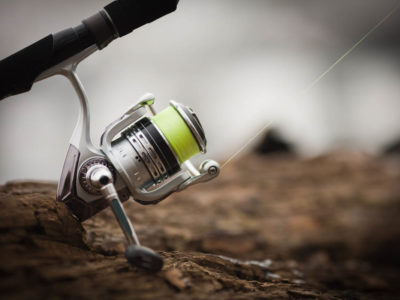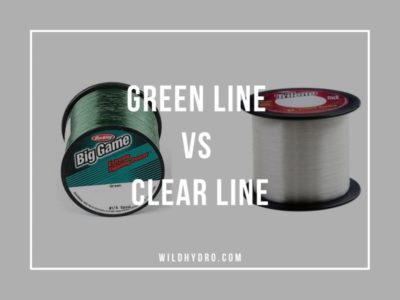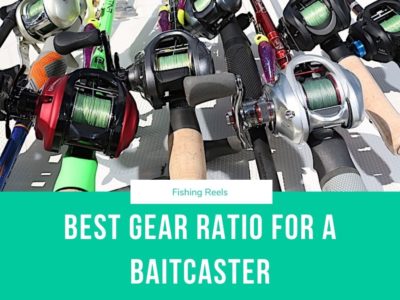In the old days, getting ready for your first cast of the day was as simple as tying on your hook or lure directly to the mainline of the fishing pole. Your grandfather managed to catch hundreds of fish just like this. But as modern technology revolutionized the fishing industry, we now have an endless array of gear options, including several types of fishing line.
So what’s the difference between fluorocarbon leader vs line?
Fluorocarbon has quickly become the pro’s choice for its abrasion resistance and the stealthy presentation it offers. But if you’re shopping for fluorocarbon line for the first time, you’ll quickly notice a massive difference in price between fluorocarbon sold as leader material and fluoro sold as mainline.
Is it worth investing in the pricier leader material version, or will you enjoy the same performance whether you use leader or mainline? Read on as we cover all the nitty-gritty details when it comes to fluorocarbon leader vs line.
Table of Contents
When Should I Use a Fluorocarbon Leader vs Line?
To better understand when to use fluorocarbon leader vs line, you’ll need to first understand the differences between the two.
Fluorocarbon is the latest fishing line technology and it offers some significant benefits over monofilament or braided line. Fluorocarbon is significantly more durable and abrasion-resistant than monofilament and it’s also thinner in diameter.
The added durability translates to a longer lifespan and less chance of a large fish breaking off your line. The thinner diameter allows you to load more line onto the spool, so you’ll be able to use the reel for a broader array of fishing scenarios.
Fluorocarbon is sold as either mainline or leader. While all fluorocarbon line is more expensive than mono or braid, you’ll notice that fluorocarbon leader material is significantly more expensive than its equivalent fluoro mainline.
The reason for the higher price is two-fold. Fluorocarbon leader material receives a special coating to make it even more abrasion resistant than regular fluoro. Fluoro leader is also stronger than its equivalent test mainline because it’s intended to withstand impact and force over a much shorter distance than the mainline.
Fluorocarbon leaders are also more expensive to manufacture, as fluoro mainline is usually made from one material. In contrast, leader material involves the fusion of two different resins to provide additional benefits. Seaguar for example uses a hard resin core to give strength and durability with a softer resin on the outside to improve knot strength and abrasion resistance.
This brings us back to the question of when you should use fluorocarbon leader vs line. In instances where you need a line that will stand up to extreme conditions, heavy structure, or toothy fish, it’s worth it to invest in fluoro leader. Using leader material can provide extra strength and abrasion resistance without you having to step up to a much wider diameter line.
Otherwise, fluorocarbon mainline will do the trick as leader material. This way you’ll enjoy all the benefits of using fluoro without the extra expense that fluoro leader commands.
How Long Should a Fluorocarbon Leader Be?
The length of your leader is entirely dependent on the type of fishing you’re doing. For most fishing, a 12–24” leader is the ideal size. When fishing in deep open waters a leader that’s 10 feet long or more is typical.
For most fishing scenarios, a shorter 2’ or less leader is ideal for several reasons.
The most crucial reason involves casting distance and knot strength. Any line-to-line knot is going to add bulk where the lines are joined. As your knot runs through the rod guides, it’s taking a beating. Not only does this reduce casting distance, but it makes knot failure more likely and it invites the possibility of wind knots as you cast.
Shorter leaders eliminate the need for your line-to-line knot to travel through the guides while also reducing the amount of line coming out from the rod when you cast, making it safer for you and anyone in the area.
Meanwhile if you’re deep dropping for ocean bottom fish or trolling, a leader as long as 10’ is common. Heavy monofilament leaders have a great deal of stretch, which helps absorb the shock of a fighting fish. This reduces both the stress on your gear and the likelihood that the fish will snap the line.
Should Leaders be Stronger than Main Line?
The conditions you’re fishing in will dictate the proper leader strength to use. It’s usually best to use a thinner leader that is weaker than your mainline. But there are also some situations where a stronger leader is required.
Most anglers will use leader material lighter than their mainline when fishing where structure and obstacles aren’t an issue. Using a lighter leader helps ensure the most natural presentation possible, and it can prevent fish who are line shy from seeing your leader and thinking twice about taking the bait.
PRO TIP: The more invisible your line is the more likely you are to get a bite!
Light leaders also offer a measure of protection for your rod if you become snagged or are contending with a fish that outclasses the tackle you’re using. A thinner, weaker leader will break before the mainline of the rod does, which helps you avoid putting too much strain on the rod and potentially breaking it.
While a lighter leader is preferred in most scenarios, there are also plenty of situations where a stronger and heavier leader is preferable.
Waters with heavy cover, rocks, bridge pilings, or other forms of structure can easily abrade your fishing line causing it to weaken or fail. In these instances, many anglers will size up their leaders to provide an additional measure of abrasion resistance.
By nature, fluoro is more abrasion resistant than the equivalent mono or braided line, but not so much that it can keep you from getting sawed off by rocks or whatever structure you’re fishing over.
Beyond worrying about structure, most large saltwater game fish have sharp teeth and they can easily bite through a leader with minimal effort if they have the chance. When fishing for these deep water pelagics, a heavier leader is a practical requirement.
The Last Cast
When it comes to fluorocarbon leader vs line, a few slight differences play a significant role in which line is the best choice for the job. Suppose you’re fishing areas of heavy structure, targeting toothy predators, or fishing other scenarios where a heavier, stronger leader is required. In that case it will be worth the extra money to invest in a fluorocarbon leader.
But if you’re using a lighter leader and aren’t as concerned with strength or abrasion resistance, there’s no reason to spend the extra money for fluorocarbon leader compared to mainline.
Do you prefer to use a Fluorocarbon leader when fishing or do you keep things simple?
Editor’s Picks



